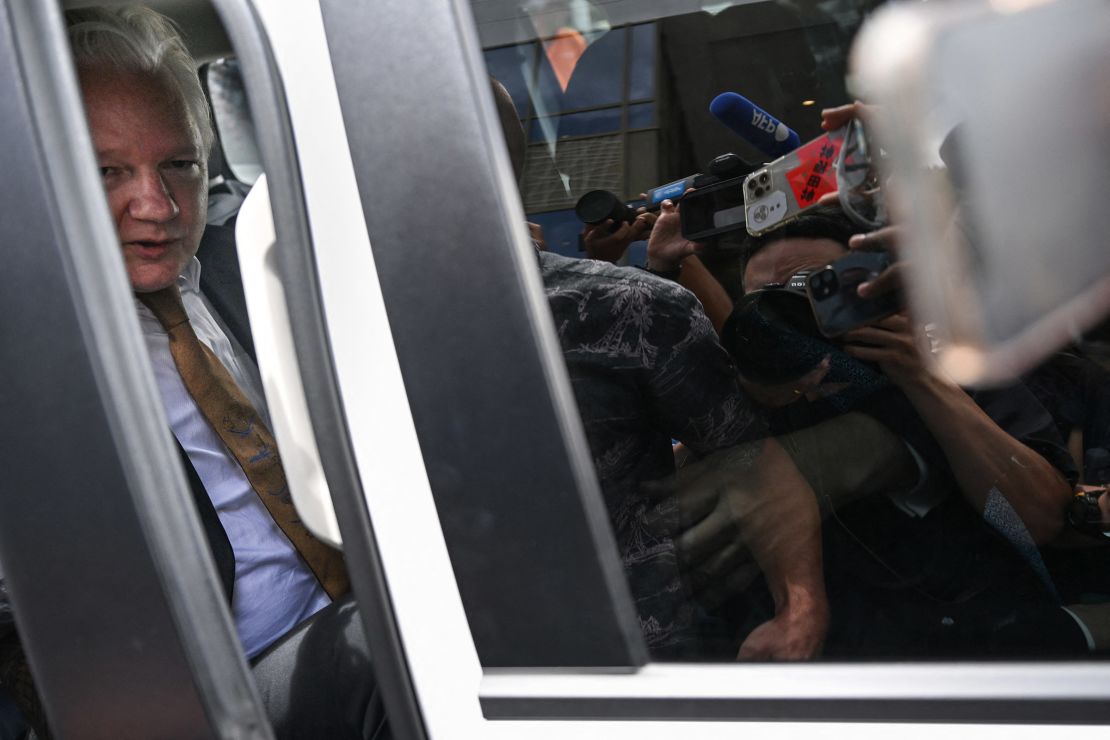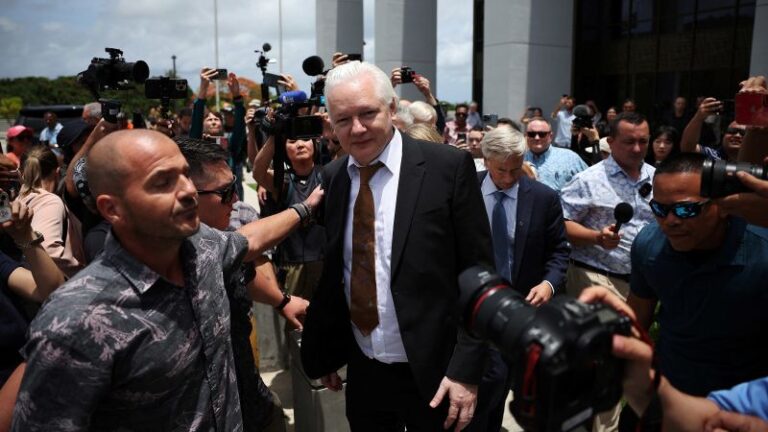Saipan, Northern Mariana Islands
CNN
—
WikiLeaks founder Julian Assange is free for the first time in 12 years after a US judge approved a surprise plea deal on Wednesday morning.
Assange walked out of the courtroom a free man, raising his hand to a worldwide audience, before driving to the airport and boarding a flight to the Australian capital, Canberra.
Speaking outside the courtroom in Saipan, a remote U.S. Pacific territory in the Northern Mariana Islands, Mr. Assange’s U.S. lawyer, Barry Pollack, said Assange had “suffered greatly in the fight for freedom of speech and freedom of the press.”
“The prosecution of Julian Assange is unprecedented in 100 years of the Espionage Act,” Pollack told reporters. “Mr. Assange revealed information that was true and newsworthy. … We firmly believe that Mr. Assange should not have been charged under the Espionage Act and should not have been engaging in the activities that journalists do every day.”
In a stunning development, the 52-year-old Australian was released from a maximum security prison in London on Monday afternoon and had already left the UK on a private jet before the agreement with the US government became known to the world.
He appeared in U.S. court in the Northern Mariana Islands to formalize the agreement and formally pleaded guilty to conspiracy to illegally obtain and disseminate classified information for his alleged role in one of the largest leaks of classified information in U.S. military history.
“Indeed, I am guilty of this charge,” Assange said in court in Saipan.
Assange has long harbored a deep distrust for the United States, even going so far as to accuse it of plotting to assassinate him, and has been hesitant to set foot on U.S. soil, so prosecutors asked for all trials to be held on one day in U.S. federal court in Saipan, the largest and capital of the Northern Mariana Islands, located about 6,000 kilometers west of Hawaii.
Justice Department prosecutors also said an island court made sense logically because of its proximity to Australia, where Assange will eventually travel to once his legal battle is over.
Kevin Rudd, a former prime minister and Australian ambassador to Washington who helped smooth negotiations with the United States, watched the hearing in court.

At the start of the plea-bargain hearing, the judge reminded Assange that he was back in the U.S. and that the court was “the smallest, the newest and the furthest from the nation’s capital.” Assange sat next to his lawyer in the courtroom and looked relaxed in a black jacket and brown tie.
Asked by Judge Ramona Manglona about the conduct that led to the indictment, Assange said, “While working as a journalist, I encouraged sources to provide information in order to publish classified information. I believe that conduct was protected by the First Amendment…While I believe the First Amendment and the Espionage Act are in conflict, I acknowledge that, given the circumstances, such a case would be difficult to win.”
In his ruling, the judge said Assange was entitled to credit for time served in a British prison.
“A sentence of 62 months seems fair and appropriate,” Manglona said. “You will walk out of this courtroom a free man and hopefully peace will be restored.”
The judge told Assange that “timing is crucial” and that she would not have been willing to plead guilty 10 years ago, adding that there were no personal victims in the case and that Assange’s actions were not known to have caused any physical harm.
The US has long argued that this self-proclaimed advocate of free speech endangers lives and poses a threat to national security.
After his release, the Department of Justice said in a statement that Assange was barred from returning to the United States without authorization “pursuant to the plea agreement.”
Assange and his whistleblower website rose to worldwide prominence in 2010 following a series of leaks by former Army intelligence analyst Chelsea Manning about the Iraq and Afghanistan wars.

The site posted a video showing a U.S. military helicopter shooting and killing two journalists and several Iraqi civilians in 2007. A few months later, the site released more than 90,000 classified documents about the Afghanistan war dating back to 2004.
In late 2010, he was asked to answer questions in Sweden about sexual assault allegations that had emerged.
Two years later, Assange sought political asylum in the Ecuadorian embassy in West London. He remained there for almost seven years until 2019, when Metropolitan police granted him refuge on a US Department of Justice extradition warrant.
The US-brokered agreement marks the culmination of a 14-year legal battle across the continent, but it was not immediately clear why it was being resolved now.
Australian officials have previously approached the issue from a diplomatic angle, and it was widely believed that Prime Minister Anthony Albanese raised Mr Assange’s case during a visit to the White House in October last year.
“I am pleased that (Assange) will be returning to Australia to be reunited with his family,” Australia’s prime minister told parliament on Wednesday.
“This achievement is the result of careful, patient and determined work,” Mr Albanese said, adding “this is about standing up for Australians around the world.”
In pictures: WikiLeaks founder Julian Assange
Assange: A pivotal moment
- 2006: Julian Assange founded the whistleblower website WikiLeaks.
- April 2010: WikiLeaks released a video in 2007 showing a US military helicopter killing civilians in Iraq.
- July 2010: WikiLeaks has published classified documents related to the Afghanistan war.
- August 2010: Sweden has launched an investigation into Assange after allegations of sexual assault surfaced, which he denies.
- June 2012: Assange entered the Ecuadorian Embassy in London seeking political asylum.
- April 2019: British police arrested Assange on behalf of the United States and requested his extradition after Ecuador revoked his asylum.
- June 2022: The British Home Secretary signed his extradition order, but he later appealed.
- May 2024: Assange will be allowed to file a new extradition request.
- June 2024: Assange has agreed to a plea deal with the US and will be allowed to be released from a British prison and return to Australia.
US President Joe Biden has suggested in recent months that Australian officials were in negotiations to extradite Assange to Australia, but the administration distanced itself from the move on Tuesday. National Security Council spokeswoman Adrienne Watson told CNN that “this is a decision made independently by the Department of Justice and has no involvement from the White House.”
In any case, Mr Assange’s wife, Stella, said on Tuesday she was “delighted” at the news that her husband had emerged from Belmarsh.
“Honestly, I can’t believe it. I don’t understand. It doesn’t feel real,” she told BBC Radio 4’s Today programme as she flew to Australia with her two children on Sunday morning, ahead of Assange’s release.
“This is a monumental day,” Assange’s half-brother Gabriel Shipton told CNN, adding that his brother’s work had changed the world.
Mr Assange said he was “glad to be free again” and was looking forward to doing the normal things he had not been able to do since spending the past five years in a maximum security prison. He said his brother was enjoying bird watching in Australia, swimming in the sea and dining out with his wife and children.
One of the things the WikiLeaks founder will have to do when he arrives in Australia is pay the government for his return flight. According to the International Campaign for Assange’s Release, he owes $520,000 for a charter flight.
The campaign is asking supporters to donate to help cover the costs of his recovery and other expenses.

